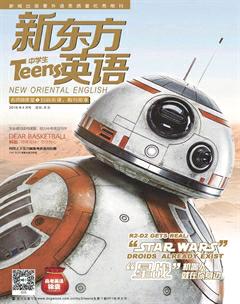“星战”机器人就在你身边
可以毫不夸张地说,《星球大战》系列中的机器人在文化上产生了巨大的影响。即使并非星战死忠粉的人可能也会记得C-3PO、R2-D2和美国导演乔治·卢卡斯(George Lucas)创造的多姿多彩的宇宙空间里的许多其他机器人。这一系列科幻电影让我们得以一窥机器人在未来世界的可能用途,但是,我们离制造出真正的R2-D2到底有多近呢?实际上,一些与星战系列中相似的科技业已问世,《星球大战》中最令人难忘的几种机器人在现实世界中业已有了与它们相对应的版本。
What's the difference between a droid and a robot? Besides "droid" being a term trademarked by George Lucas, droids, as portrayed on film, have far more independence and intelligence than most robots that exist today. While some robots have a limited artificial intelligence (AI) that allows them to make lower-function decisions, most require direct commands from a human in order to work.
While many researchers are trying to develop AI that can handle more-complex problem solving and can adapt to different environments, the world is still a long way from having a robot with the same level of intelligence as R2-D2. Still, the field of robotics has made significant gains.
同样是机器人,droid和robot有什么区别?除了“droid”这个词是乔治·卢卡斯的标志之外,按照电影中的描述,droids远比现存的大多数robots都更加独立,并拥有更高的智能。虽然有些robots具有的有限的人工智能让它们可以自行做出较为低功能的决定,但它们大多需要人类的直接指令才能工作。
尽管有许多研究人员在努力研制能够解决更加复杂的问题并适应不同环境的人工智能机器人,但是距离制造出与R2-D2拥有同等智力水平的机器人还有很长一段路要走。不过,人们在机器人研发领域还是取得了长足的进展。
Driving Droids
If you were one of the millions who rode the "Star Tours" ride at Disneyland before 2011, you may remember RX-24, the pilot droid tasked with flying riders to the forest moon of Endor. However, things go awry2) during the ride after RX-24 gets caught in a fight between the Rebels and the Empire.
While RX-24 was a terrible pilot, developers are currently working on creating a robot that can actually handle the perils3) of driving and flying. For example, Google is testing a self-driving car that can operate safely and autonomously in regular traffic. The vehicle uses laser technology and a system of sensors to generate a 3D map of its environment, which enables the car to drive itself.
The AI is a work in progress, and Google's driverless car still requires a "backup" human driver to ride along and make sure nothing goes wrong. But if tests go well, self-driving cars could rule the streets in the near future.
Medical Droids
In Star Wars Episode V: The Empire Strikes Back, a 2-1B medical droid nurses Luke Skywalker back to health by keeping him in a tank full of a substance that can rapidly heal wounds. While this material, called "bacta" in the film, and the 2-1B droid are not real, advancements in medical technology are introducing robots into doctor's offices and hospitals.
For example, engineers at ?colePolytechnique de Montréal have been working on creating "microbots" that can roam4) the human body and perform delicate tasks, such as clearing arteries, sealing wounds and exploring the artery system.
In the movie, the 2-1B has an independent AI, meaning it can function much like a human doctor. While existing robots do not have sophisticated AI that enables them to stand in for5) real physicians, many devices have been built to allow doctors to attend to6) patients remotely. The Robotic Nursing Assistant, for instance, helps physicians use extremely accurate tools to treat their patients, while the other telemedicine assistants let doctors virtually care for their patients, even across great distances.
Astromech Droids
Who doesn't love R2-D2? In the "Star Wars" universe, this small robot has more functions than a Swiss Army knife, and more personality than a robot that speaks only in "beeps" and "boops" should have. R2-D2 is known as an astromech droid, which is a type of multifunctional robot that can respond to a diverse range of problems.
While it's easy to build a working replica7) of R2-D2, there are no R2 units that truly function as they were imagined in the "Star Wars" films. The closest thing is a bot developed by NASA in 2006 to perform maintenance in microgravity. The so-called SPHERE is a bot that helps astronauts with docking operations, along with satellite servicing, assembly and emergency repairs. The bot resembles the training droid that Luke Skywalker fights in Star Wars Episode IV: A New Hope, but has the functionality of an R2 unit.
Protocol8) Droids
R2-D2 never goes anywhere without his neurotic9) friend C-3PO, who can act as servant, translator or companion. Unlike R2, C-3PO is designed for the explicit purpose of understanding humanoids and communicating with them.
The most famous real-life humanoid bot is Honda's Asimo, a bipedal10) robot designed to move similarly to humans and resemble them in other ways. Asimo can physically respond to human actions as well as respond to human voices. The robot performs a variety of functions, including playing soccer, gesturing, reading faces and moving around in its environment. Asimo has limited language abilities, and can only respond to audible commands with short phrases and physical gestures.
If you want something with more "conversational" ability, look to Japan's Otonaroid. This android is one of two bots that have been "hired" to work in Tokyo's National Museum of Emerging Science and Innovation. Otonaroid will be able to converse directly with visitors, while her "sister" android, Kodomoroid, will continuously read aloud world news reports. The robots don't generate their own voices, though; the bots are simply the mouthpieces for human operators. Similar tech is used to control "Crush the Turtle" at the "Turtle Talk with Crush" attraction at Walt Disney World's Epcot theme park.
驾驶机器人
如果你是2011年之前在迪士尼乐园玩过“星际之旅”项目的众多游客之一,你也许会记得RX-24,那个负责将乘客送往森林卫星恩多的机器人飞行员。可是在RX-24被卷入反叛军和帝国之间的一场战斗后的飞行途中,一切便不对劲了。
RX-24确实是个蹩脚的飞行员,不过,开发人员目前正在致力于制造出能够真正应对驾驶和飞行险情的机器人。例如,谷歌正在对一款能够在正常路况下安全自主行驶的自动驾驶汽车进行测试。这辆汽车运用激光技术,通过一系列传感器生成周边环境的3D地图,从而实现自动驾驶。
这类人工智能机器人仍在改进之中,谷歌的无人驾驶汽车也仍然需要一名人类驾驶员作为“后备”陪驾,以确保不会出什么岔子。但是,如果测试进展顺利,自动驾驶汽车在不久的将来或许将成为马路上的主力。
医疗机器人
在《星球大战5:帝国反击战》中,一个2-1B医疗机器人把天行者卢克浸泡在一个液槽中来照料,让他恢复了健康,那个液槽中装满了一种能够快速修复伤口的物质。虽然这种在影片中被称作“bacta”的物质和2-1B机器人在现实中并不存在,但随着医疗技术的进步,机器人已经开始进入医生的办公室和医院。
例如,蒙特利尔综合理工学校的工程师们一直在研制这样的“微型机器人”:它们可以在人体内移动,承担诸如疏通动脉血管、封堵伤口和检查动脉系统这样的棘手工作。
在电影中,2-1B拥有独立的人工智能,也就是说,它基本上可以像人类医生那样工作。虽然现有的机器人还不具备如此复杂的人工智能以代替真正的医生,但已经有许多设备问世,使得医生可以远程照顾病患。例如,机器人护士助手可以协助医生使用极其精密的工具为患者治疗,而另一种远程医疗助手让医生即使与病人相隔万里,实际上也可以照料患者。
宇航技工机器人
谁不喜爱R2-D2呢?在“星战”的世界里,这个小机器人的功能比瑞士军刀还要多,而它的个性之丰富也不像是一个只能“哔卟”作响的机器人会有的。R2-D2被称作宇航技工机器人,这是一类能够应对多种问题的多功能机器人。
虽然制作一个可以使用的R2-D2的复制品并非难事,但真正具备“星战”系列电影中所设想的那些功能的R2类机器人并不存在。和它最接近的是美国国家航空航天局在2006年研制的一个在微重力条件下执行维护任务的机器人。这个叫做SPHERE的机器人能够协助宇航员进行太空对接操作,还能执行卫星检修、组装和紧急维修任务。它的外观类似于《星球大战4:新希望》中与天行者卢克交手的训练机器人,但它的功能性和R2类机器人一样。
礼仪机器人
R2-D2无论去哪儿,身边都少不了那位神经质的朋友C-3PO。C-3PO可以充当仆人、翻译或者同伴。和R2不同,C-3PO就是专门设计来了解类人机器人并和它们沟通的。
在现实中,最著名的类人机器人是本田公司的阿西莫,这个两足机器人设计得像人一样可以行走,在其他许多方面也和人类相似。阿西莫能够对人的动作和声音做出肢体反应。它具备多种功能,包括踢足球、做手势、人脸识别以及在其所处的环境中四处走动。阿西莫具备的语言能力有限,只会用短语和肢体动作对声音指令做出回应。
如果你需要一个“对话”功能更强的机器人,不妨看看日本的成人机器人。它是“受雇”在位于东京的日本科学未来馆工作的两个机器人中的一个。成人机器人能够直接与游客对话,而它的“妹妹”儿童机器人则不停地大声朗读世界新闻报道。不过,这两个机器人并不会自己发声,它们只是操作人员的传声筒。在沃尔特·迪士尼世界的明日世界主题公园,相似的技术还被用来控制“与克拉什对话”游戏中的“海龟克拉什”。
1. droid [dr??d] n. (科学幻想小说中的)人形机器人
2. go awry: (事)出岔子,失败
3. peril [?per?l] n. 极大的危险
4. roam [r??m] vt. 在……随便走;漫步;闲逛
5. stand in for: 代替
6. attend to: 照料;看护
7. replica [?repl?k?] n. 复制品
8. protocol [?pr??t?k?l] n. 礼仪
9. neurotic [nj???r?t?k] adj. 神经质的
10. bipedal [?ba??pi?dl] adj. 有两足的

